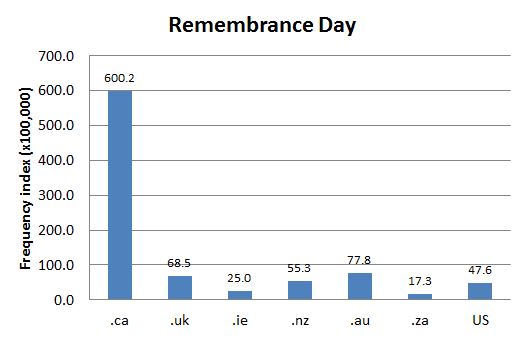DCHP-2
Remembrance Day DCHP-2 (October 2016)
n. — Military
November 11. The anniversary of the armstice at the end of the First World War in 1918 and a statutory holiday in most provinces.
Type: 4. Culturally Significant — Between 1919 and 1930, the terms Remembrance Day and Armistice Day were used interchangeably. In 1931 the name was officially changed to Remembrance Day, emphasizing the memory of the war and the soldiers who died in battle, rather than the armistice, which was a political achievement (see Canadian Encyclopedia reference).
The initial Armistice Day Act, adopted in May 1921, stated that a memorial day would be held on the Monday of the week in which November 11th fell. However, this decision meant an overlap with Thanksgiving Day, which was celebrated in November until 1957 (see Canadian Thanksgiving), and the overlap was unpopular with veterans and the general public alike (see the 1921 quotation). In 1931, a bill was passed stating that Remembrance Day should be observed on November 11 and "on no other date" (see Canadian War Museum reference and the 1931 quotation).
Since 1919, the day has been marked with the observance of two minutes of silence at 11 a.m. and memorial gatherings. The term is culturally salient, because by the end of the war Canadian soldiers were winning major battles under the command of a Canadian-born general, Sir Arthur Currie. Their success continued the process of Canadian national independence from Britain.
The term is used in the UK as well, and in other Commonwealth countries, yet, as Chart 1 shows, the term is most frequent in Canada.
See also Gage-1, s.v. "Remembrance Day", ITP Nelson, s.v. "Remembrance Day", which is described as "in Canada", and OED-3, s.v. "Remembrance Day", W-3, s.v. "Remembrance Day", AHD-5, s.v. "Remembrance Day".See also: Canadian Thanksgiving poppy Poppy Day
References:
- AHD-5
- Canadian Encyclopedia s.v. "Remembrance Day" Accessed 30 Jun. 2016
- Canadian War Museum "Remembrance Day Online Exhibit" Accessed 22 Aug. 2013
- Gage-1
- ITP Nelson
- OED-3
- W-3
Images:
Chart 1: Internet Domain Search, 5 Oct. 2012
